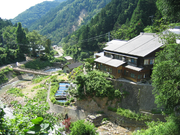
Jigokudani Monkey Park
Encyclopedia

Yamanouchi, Nagano
is a town located in Shimotakai District, Nagano, Japan.As of 2003, the town has an estimated population of 15,326 and a density of 57.63 persons per km². The total area is 265.93 km².The Shiga Kōgen ski resort is located in Yamanouchi.-Landmarks:...
, Shimotakai District
Shimotakai District, Nagano
Shimotakai is a district located in Nagano, Japan.As of 2003, the district has an estimated population of 25,179 and a density of 59.50 persons per km². The total area is 423.19 km².-Towns and villages:*Kijimadaira*Nozawaonsen...
, Nagano Prefecture
Nagano Prefecture
is a prefecture of Japan located in the Chūbu region of the island of Honshū. The capital is the city of Nagano.- History :Nagano was formerly known as the province of Shinano...
, Japan
Japan
Japan is an island nation in East Asia. Located in the Pacific Ocean, it lies to the east of the Sea of Japan, China, North Korea, South Korea and Russia, stretching from the Sea of Okhotsk in the north to the East China Sea and Taiwan in the south...
at 36.732799°N 138.4627°W. It is part of the Joshinetsu Kogen National Park
Joshinetsu Kogen National Park
is a national park in the Chubu region, Honshū, Japan. It is divided into two separate areas: the Southern Niigata/North Nagano Area and the East Nagano Area....
(locally known as Shigakogen), and is located in the valley of the Yokoyu-River, in the northern part of the prefecture. The name Jigokudani, meaning "Hell's Valley", is due to the steam and boiling water that bubbles out of small crevices in the frozen ground, surrounded by steep cliffs and formidably cold and hostile forests.
The heavy snowfalls (snow covers the ground for 4 months a year), an elevation of 850 meters, and being only accessible via a narrow two kilometer footpath through the forest, keep it uncrowded despite being relatively well-known.
It is famous for its large population of wild Japanese Macaque
Japanese Macaque
The Japanese macaque , historically known as saru , but now known as Nihonzaru to distinguish it from other primates, is a terrestrial Old World monkey species native to Japan....
s (Macaca fuscata), more commonly referred to as Snow Monkeys, that go to the valley during the winter, foraging elsewhere in the national park during the warmer months. Starting in 1963, the monkeys descend from the steep cliffs and forest to sit in the warm waters of the onsen
Onsen
An is a term for hot springs in the Japanese language, though the term is often used to describe the bathing facilities and inns around the hot springs. As a volcanically active country, Japan has thousands of onsen scattered along its length and breadth...
(hotsprings), and return to the security of the forests in the evenings.
Jigokudani is not the farthest north that monkeys live. The Shimokita Peninsula
Shimokita Peninsula
The Shimokita Peninsula is the remote northeastern cape of the Japanese island of Honshū, stretching out towards Hokkaidō. Administratively the area is a part of Aomori Prefecture....
is at the northern part of the Honshū island and the northwest area of this peninsula, latitude +41°31' longitude +140°56', approximately 500 km or 310 miles north from Jigokudani is the northern limit of Japanese Macaque habitat. No primate is known to live in a colder climate.

